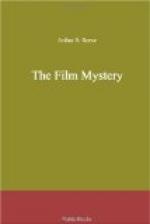Werner smiled. “I guess those boys had enough of Tarrytown. They rolled into the yard, both of them, while you and Mr. Jameson and Manton were stopping to watch the people in the water.”
“I see!” Kennedy gave me a side glance. “Where are the dressing rooms?” he inquired. It was a random shot.
Werner pointed to the end of the hall, toward the washroom. “In the next building, on this floor—that is, the principals’. It’s a rotten arrangement,” he added. “They come through sometimes and use our lavatory, because it’s a little more fancy and because it saves a trip down a flight of stairs. Believe me, it gets old Manton on his ear.”
VII
ENID FAYE
Behind Werner was the assistant director, to whom I had given little attention at the time of the examination of the various people in the Phelps library. Even now he impressed me as one of those rare, unobtrusive types of individuals who seem, in spite of the possession of genuine ability and often a great deal of efficiency, to lack, nevertheless, any outstanding personal characteristics. As a class they are human machines, to be neither liked nor disliked, never intruding and yet always on hand when needed.
“This is Carey Drexel, my assistant,” Werner stated, forgetting that Kennedy had questioned him at Tarrytown, and so knew him. “There are a few people I simply must see and I’m tied up, therefore, for perhaps half an hour; and Manton’s downstairs still trying to locate Millard for you. But Carey’s at your disposal, Mr. Kennedy, to show you the arrangement of the studio and to cooperate with you in any way if you think there’s any possible chance of finding anything to bear upon Stella’s death here.”
If Werner was the man who had used the towel, I could see that he was an actor and a cool villain. Of course no one could know, yet, that we had discovered it, but the very nonchalance with which it had been thrown into the basket was a mark of the nerve of the guilty man. It was more than carelessness. Nothing about the crime had been haphazard.
Kennedy thanked Werner and asked to be shown the studio floor used in the making of “The Black Terror.” Carey led the way, explaining that there were actually two studios, one at each end of the quadrangle, connected on both sides by the other buildings; offices and dressing rooms and the costume and property departments at the side facing the street; technical laboratories and all the detail of film manufacture in a four-story structure to the rear. Most of Werner’s own picture was being made in the so-called big studio, reached through the dressing rooms from the end of the corridor where we stood.
I had been in film plants before, but when we entered the huge glass-roofed inclosure beyond the long hallway of dressing rooms I was impressed by the fact that here was a place of genuine magnitude, with more life and bustle than anything I had ever imagined. The glass had, however, been painted over, because of late years dark stages, with the even quality of artificial light, had come into vogue in the Manton studios in place of stages lighted by the uneven and undependable sunlight.




